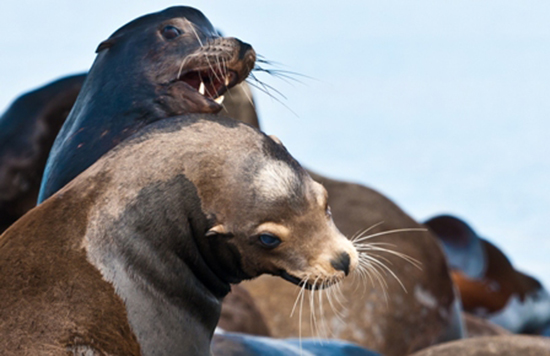In recent years, more California sea lions have begun swimming more than 140 miles up the Columbia River to Bonneville Dam to prey on adult spring Chinook salmon, winter steelhead, and white sturgeon in increasing numbers. Generally arriving from mid-to-late February and leaving by the first week in June, these male sea lions are gaining weight in preparation for the summer mating season. See Corps of Engineers fact sheet on sea lions at Bonneville Dam..

Corps biologists began gathering data on sea lion presence and predation at the dam in 2001, when six California sea lions were documented. In 2002—the first fulls season of monitoring—30 sea lions were counted. By 2007, stellar sea lions were appearing at the Dam as well. In 2010, the two species of marine mammals numbered about 160 and consumed an estimated 6,081 adult salmon, steelhead and sturgeon.
The Corps has implemented a variety of sea lion deterrents, from physical barriers to non-lethal harassment. Sea lion exclusion devices installed at Bonneville Dam have been helpful in preventing sea lions from entering the fish ladders through the 12 primary fish way entrances. The Columbia River Inter tribal Fish Commission conducts monitoring and non-lethal harassment to deter the sea lions downstream of the dam.
In 2008,NOAA Fisheries granted the states of Oregon,Washington and Idaho lethal removal authority after they petitioned under the Marine Mammal Protection Act.(California sea lions are protected under MMPA.) The program was suspended in 2010 as a result of a court order. Seechronology of authorizations and court actions here. NOAA re-authorized lethal removal in March 2012.
Since 2008, the States have removed 38 California sea lions, 10 of which were placed in aquariums. All those euthanized were known predators that had met the criteria determined by a sea lion task force for lethal removal: each California sea lion was individually identified; each had been observed in the Bonneville Dam tail race on at least five days; each had been observed taking at least one salmonid; and each one had been present during active hazing conditions.
Read more about NOAA's sea lion removal authorization here.